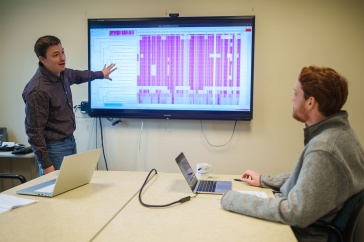
Mycorrhizal fungi are microorganisms that attach to plant roots, effectively extending the plant’s access to nutrients and water. Greater than 90 percent of all plants have this fungus attached to their roots, and many plants could not survive without it. (Credit: Serita Frey)
NHAES Research by Dr. Serita Frey |
|
|
|
Microbial Traits, not Plants, |
|
Scientists Receive $1.7 Million to |
Serita Frey, UNH professor of natural resources and the environment and researcher with the New Hampshire Agricultural Experiment Station, recently authored a state-of-
the-science article, Mycorrhizal Fungi as Mediators of Soil Organic Matter Dynamics, that addresses a controversy among scientists about whether or not mycorrhizal fungi contribute to the soil carbon cycle. (Spoiler alert: They do.)
Mycorrhizal fungi are microorganisms that attach to plant roots, effectively extending the plant’s access to nutrients and water. Greater than 90 percent of all plants have this fungus attached to their roots, and many plants could not survive without it.
For a nonscientist working through Frey’s comprehensive summation of what’s known about mycorrhizal fungi, there is one sentence that stands out as simple to grasp: two-times more carbon is stored in soil than in all vegetation and the atmosphere combined. This arresting fact gives instantaneous meaning to the intricacies of the soil carbon cycle: a mass discharge of this stored greenhouse gas could have catastrophic implications for the environment.
Frey says historically plant-centric research on mycorrhizal fungi ignored the possibility that these hard-working microorganisms influence soil’s ability to store carbon. Current research, however, confirms that they are both facilitators of carbon storage and influencers of organic matter decomposition.
“Recently there been increasing interest in what these mycorrhizal fungi are doing for carbon storage in the soil,” Frey said. “They do contribute. We now know that a lot of that carbon plants take out of the atmosphere goes into the mycorrhizae and that then, because fungi are microscopic and they get into places in the soil that roots can’t go, that carbon is stabilized long term.”
What’s more, the knowledge Frey makes plain can help scientists predict how microorganisms in soil respond to environmental changes and figure out how to keep soil carbon stores stable.
“When you think about climate change mitigation strategies,” Frey continued, “the fungal component has an important role in a carbon sequestration strategy. There’s the protection of carbon in soil and the release of carbon from soil, and it’s the balance of those two processes that’s going to influence the role that soils play in greenhouse gas production or mitigation. The mycorrhizae are doing both of those things.”
Frey was invited by Sarah Hobbie, professor of ecosystem ecology at the University of Minnesota and one of the editors of the Annual Review of Ecology, Evolution, and Systematics, to write the state-of-the-science-paper, a request that is commonly considered an honor among researchers. The internationally recognized soil expert was recently named among the Web of Science Group’s 2019 Highly Cited Researchers, a designation that includes just 0.1 percent of the world’s scientists.
“To me it’s just always fascinating that the activities of something that’s microscopic, that we can’t see and that few people think much about, can actually scale up and have implications for the whole planet,” Frey said. “To me, that’s what blows my mind pretty much every day.”
Founded in 1887, the NH Agricultural Experiment Station at the UNH College of Life Sciences and Agriculture is UNH’s original research center and an elemental component of New Hampshire's land-grant university heritage and mission. We steward federal and state funding, including support from the USDA National Institute of Food and Agriculture, to provide unbiased and objective research concerning diverse aspects of sustainable agriculture and foods, aquaculture, forest management, and related wildlife, natural resources and rural community topics. We maintain the Woodman and Kingman agronomy and horticultural research farms, the Macfarlane Research Greenhouses, the Fairchild Dairy Teaching and Research Center, and the Organic Dairy Research Farm. Additional properties also provide forage, forests and woodlands in direct support to research, teaching, and outreach.
-
Written By:
Sarah Schaier | College of Life Sciences and Agriculture


















































